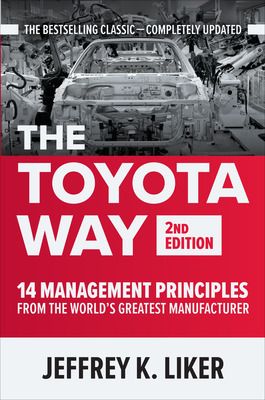The Toyota Way, Second Edition: 14 Management Principles from the World's Greatest Manufacturer
Acknowledgments
Preface: The Wonderful Wacky World of Lean
INTRODUCTION The Toyota Way: Using Operational Excellence
as a Strategic Weapon
A Storied History: How Toyota Became
the World’s Best Manufacturer
PART ONE
PHILOSOPHY: LONG-TERM SYSTEMS THINKING
PRINCIPLE 1 Base Your Management Decisions on Long-Term
Systems Thinking, Even at the Expense of Short-Term
Financial Goals
PART TWO
PROCESS: STRUGGLE TO FLOW VALUE
TO EACH CUSTOMER
PRINCIPLE 2 Connect People and Processes Through Continuous
Process Flow to Bring Problems to the Surface
PRINCIPLE 3 Use “Pull” Systems to Avoid Overproduction
PRINCIPLE 4 Level Out the Workload, Like the Tortoise,
Not the Hare (Heijunka)
PRINCIPLE 5 Work to Establish Standardized Processes as
the Foundation for Continuous Improvement
PRINCIPLE 6 Build a Culture of Stopping to Identify
Out-of-Standard Conditions and Build in Quality
PRINCIPLE 7 Use Visual Control to Support People in
Decision-Making and Problem Solving
PRINCIPLE 8 Adopt and Adapt Technology That Supports
Your People and Processes
PART THREE
PEOPLE: RESPECT, CHALLENGE, AND GROW
YOUR PEOPLE AND PARTNERS TOWARD
A VISION OF EXCELLENCE
PRINCIPLE 9 Grow Leaders Who Thoroughly Understand the Work,
Live the Philosophy, and Teach It to Others
PRINCIPLE 10 Develop Exceptional People and Teams Who
Follow Your Company’s Philosophy
PRINCIPLE 11 Respect Your Value Chain Partners by Challenging
Them and Helping Them Improve
PART FOUR
PROBLEM SOLVING: THINK AND ACT SCIENTIFICALLY
TO IMPROVE TOWARD A DESIRED FUTURE
PRINCIPLE 12 Observe Deeply and Learn Iteratively (PDCA)
to Meet Each Challenge
PRINCIPLE 13 Focus the Improvement Energy of Your People
Through Aligned Goals at All Levels
PRINCIPLE 14 Learn Your Way to the Future Through Bold Strategy,
Some Large Leaps, and Many Small Steps
PART FIVE
CONCLUSION: BE THOUGHTFUL
AND EVOLVE YOUR ENTERPRISE
Grow Your Own Lean Learning Enterprise—Getting
Ideas and Inspiration from the Toyota Way
APPENDIX An Executive Summary and Assessment
of the 14 Principles
Glossary
For Further Reading
Index
The bestselling guide to Toyota’s legendary philosophy and production system—updated with important new frameworks for driving innovation and quality in your business
One of the most impactful business guides published in the 21st Century, The Toyota Way played an outsized role in launching the continuous-improvement movement that continues unabated today.
Multiple Shingo Award-winning management and operations expert Jeffrey K. Liker provides a deep dive into Toyota’s world-changing processes, showing how you can learn from it to develop your own improvement program that fits your conditions. Thanks in large part to this book, managers across the globe are creating workforces and systems that produce the highest-quality products and services, establish and retain customer loyalty, and drive business profitability and sustainability. Now, Liker has thoroughly updated his classic guide to include:
- Completely revised data and updated information about Toyota’s approach to competitiveness in the new world of mobility and smart technology
- Illustrative examples from manufacturing and service organizations that have learned and improved from the Toyota Way
- A fresh approach to leadership models
- The brain science and skills for learning to think scientifically
- How Toyota applies Hoshin Kanri, a planning process that aligns objectives at all levels and marries them to business strategy
Organized into thematic sections covering the various aspects of the Toyota Way—including Philosophy, Processes, People, and Problem Solving—this unparalleled guide details the 14 key principles for building the foundation of a powerful improvement system and managing it for ultimate competitive advantage.
With The Toyota Way, you have an inspiration and a model of how to set a direction, continuously improve and learn at all levels, continually "flow" value to satisfy customers, improve your leadership, and get quality right the first time.

